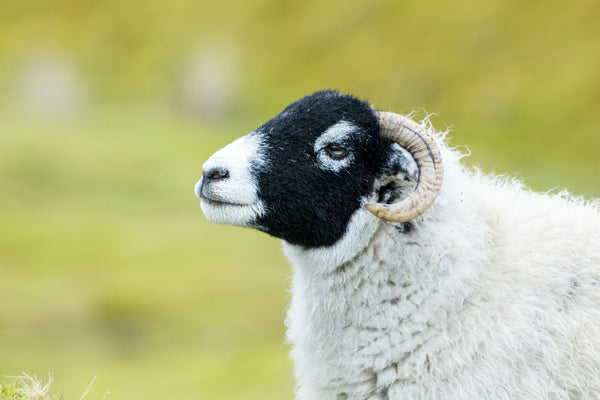Know Your Fiber: Swaledale Wool
Posted on October 01 2020

Curving horns, elegant black faces with white muzzles, and a woolen coat perfectly adapted to a rainy environment – meet the Swaledale! These adorable sheep can be found around the world but have their home in the upland moors of England.
Taking their name from the one of the most northern dales, or valleys, in the Pennine Hills, Swaledale sheep can be found all over the hilly and mountainous areas of Great Britain. Their origin is hard to pin down. Certainly at least some of their genetics come from the early flocks raised by people in the late-Neolithic period who lived on what would eventually become the British Isles. However, it has been popularly thought by more than one historian that additional contributions to the breed may have made by ovine ancestors outside the British Isles. Roman sheep, sheep imported to the isles by monasteries, and even Argali (a mountain sheep making its home in the mountainous regions of east Asia), have been advanced as possible ancestors. In truth, though, we may never absolutely establish the ancestry of the Swaledale. However, thanks to modern genetic science, we can at least disregard the legend of Argali ancestry – the genetics and number of chromosomes are too different for such ancestry to be likely.
What we do know about the Swaledale is that belong to a family of dual-purpose, black-faced sheep that have lived in the upland regions of the British Isles for millennia. These sheep thrive on land that would be considered by any measure to be poor farmland. Wandering the upland moors and foraging for food, Swaledale sheep are perfectly suited for their environment. As they should be, since although early efforts were made to improve Swaledales by breeding them with New Leicester crosses, breeders ultimately decided it was best to let the surrounding environment shape the breed. Interestingly, one of the traits for which the Swaledale is well regarded is that its lighter fleece dries out quickly after a rainstorm, making it less likely that the sheep become top-heavy and tip over. Considering that the areas of the U.K. in which they live are known to be rainy for all but a few months out of the year, this is a rather important quality – sheep that have tipped over onto their backs need human help to right themselves, and those that do not receive it can perish.
It is hard to know exactly when Swaledales came to be considered distinct breed from the other black-faced sheep of the uplands. However, one of the first written accounts of Swaledale sheep is found the in British Breeds of Livestock, published by the Great Britain Board of Agriculture and Fisheries in 1910. Nine years later in 1919, a group of Swaledale farmers gathered at the Tan Hill Pub, the highest pub in the U.K., and with some conversation and perhaps a few pints, the Swaledale Sheep Breeders’ Association was born.
Over the last century and all the way up through today, Swaledale sheep have largely been raised to breed with Bluefaced Leicesters. This breeding produces a sheep known as the North of England Mule, more commonly known and just the Mule. The resulting Mule sheep are highly valued of for their lamb and mutton. However, to create Mules, you need a Swaledale ewes, and when you have around 1,200 flocks of mainly Swaledale ewes and wethers, you also get wool. A lot of it, luckily for crafters like us!
Although Swaledale sheep wool is cream colored, their kemp is not necessarily the same color as the wool. As a result, much of the Swaledale fiber on the market is light gray – a result of both the wool and the kemp being combined into spinnable top. This combination of wool and kemp makes for some interestingly textured yarn, which many weavers enjoy using to create durable woven tweeds, while other crafters will enjoy using this wool for making durable outerwear and rugs. Swaledale staple length can range from 4-8 inches, and with fiber widths of 35-45 microns, this fiber falls firmly in the coarse range of wools.
If you want to get your fingers into some Swaledale, check out our Swaledale top! This and other single breed wools are available at our shop online and at our brick-and-mortar location. Get to crafting, you wild and woolly crafters!


Follow US